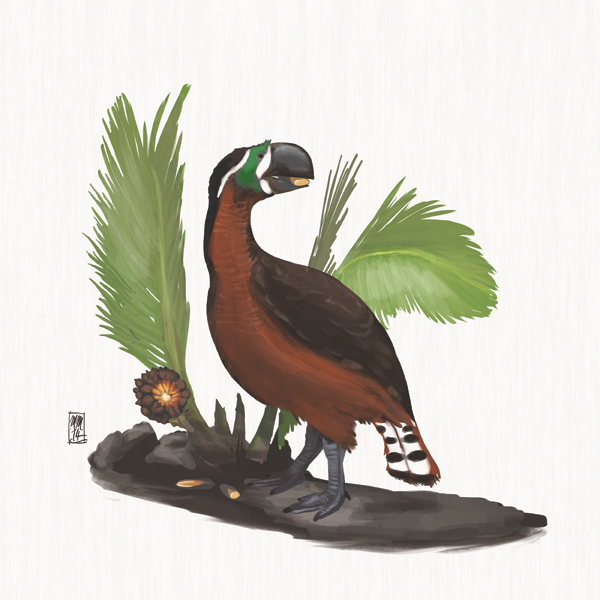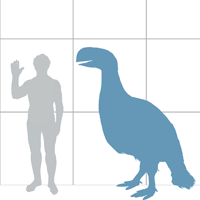home > natural history
Diatryma gigantea
"gigantic foramen"

Purchase Print
Despite the fact that birds outnumber mammals by far in number of living species, the Cenozoic era is commonly called the Age of Mammals, in contrast to the earlier Mesozoic era, the Age of Dinosaurs. Despite the overwhelming diversity of birds, it's true that modern species, with a few exceptions, are excluded from the realm of megafauna. Despite their large numbers, birds hardly "dominate" the large herbivore or carnivore niches in most terrestrial ecosystems.
But 10 million years after an asteroid wiped out all of the dinosaurian megafauna, avian dinosaurs were competing with mammals to reclaim their niches. One of the most famous of these contenders was the Diatryma, a group of massive, huge-beaked North American ground birds. Diatrymes were long assumed to be predators, like the (probably) superficially similar "terror birds" (Phorusrhacidae) of South America. However, diatrymes lacked any obvious predatory adaptations besides their massively powerful beaks. The beak margins were flat, not hooked, and the lower legs short. Rather than runnng birds, they must have had awkward, waddling gaits. Footprints of a diatryme or other gastornithid found in Washington state show that their foot claws lacked curved talons, but were short and blunt. It is possible, then, that diatrymes were herbivores or omnivores, and that their powerful beaks were used to eat hard seeds or other tough plant material (the illustration above depicts one eating from a nipa fruit). Rather than feasting on the contemporary early horse Eohippus, Diatryma may have grazed alongside it.
The taxonomy of these birds is debated despite never being properly studied. Though many species from both North America and Europe have been classified in the genus Diatryma, no real phylogenetic study has been done. A study by Larry Martin in the 1980s concluded that the only complete specimens, assigned to D. steini in 1917, are probably synonyms of Cope's original species, D. giganteus. This seems pretty likely, since the two were roughly contemporary. Less certain is the assignment of all diatryme species to the European genus Gastornis, the type species of which lived much earlier (late Paleocene) and on a different continent. Generic assignments are subjective, but I would recommend keeping them separate until a decent comparison and phylogeny is done.
Image Details:
Media: Photoshop CS5 and Wacom Bamboo
License:
ALL RIGHTS RESERVED
DESCRIPTION
Length: 2m (6ft)
Weight: 300kg
Location: Willwood Formation, Wyoming
Time: Ypresian age, Eocene (53 mya)
CLASSIFICATION
Kingdom: Animalia
Phylum: Chordata
Class: Aves
Order: Anseriformes
Family: Gastornithidae
Genus: Diatryma
Species: D. gigantea
SYSTEMATICS
Sauropsida
Diapsida
Archosauria
Ornithosuchia
Dinosauria
Aves
Anseriformes
Gastornithidae
